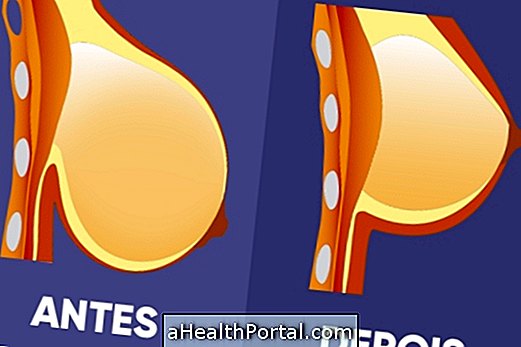Aesthetic surgery to put silicone prostheses may be indicated when the woman has very small breasts, is afraid of not being able to breastfeed, has noticed some reduction in her size or lost a lot of weight. But it can also be indicated when the woman has breasts of different sizes or has had to remove the breast or part of the breast due to cancer.
This surgery can be done from the age of 15 with parental consent, and it is done with general anesthesia, taking about 45 minutes, and can be with a short stay of 1 or 2 days, or even in an outpatient setting, when is discharged on the same day.
The most common complications are chest pain, decreased sensitivity and rejection of the silicone prosthesis, called a capsular contracture, which may occur in some women. Other more rare complications are the rupture due to some strong blow, the hematoma and the infection.
After deciding to put silicone on the breasts the woman should look for a good plastic surgeon to perform the procedure safely, thus reducing the risks of surgery. See another surgery option that uses body fat to increase breasts at Learn all about Technique that boosts breasts and butt without silicone.
How to choose silicone prosthesis
The silicone implants should be chosen between the surgeon and the woman, and it is important to decide:
- Form of the prosthesis: it can be in the form of a drop, more natural, or in a round shape, more appropriate for women who already have some breast. This round shape is safer because the droplet shape is more likely to rotate inside the sinus, becoming crooked. In the case of the round prosthesis you can also achieve a natural way by injecting fat around, called lipofilling.
- Profile of the prosthesis: may have a high, low or medium profile, and the higher the profile is steeper the breast, but also a more artificial result;
- Size of the prosthesis: varies according to the height and physical structure of the woman, being common use prostheses with 300 ml. However, prostheses over 400 ml should only be placed on tall women with a wider thorax and hip.

- Place of prosthesis placement: the silicone can be placed above or below the pectoral muscle. It is best to put on top of the muscle when you have enough skin and fat to have a natural appearance, while it is recommended to put under the muscle when you have practically no breast or are very thin.
In addition, the prosthesis may be silicone or saline and may have a smooth or rough texture, and it is recommended to use cohesive and textured silicone, which means that in the case of breaking it does not disintegrate and decreases the risk of infection, there being less chance of developing rejection, infection, and silicone leaving the breast. Nowadays, completely flat or heavily textured dentures appear to cause a greater number of contractures or rejection. See what are the main types of silicone and how to choose.
How is breast augmentation performed?
In breast augmentation or plastic surgery with a silicone prosthesis, a small cut is made in the two breasts around the areola, in the lower part of the breast or even in the armpit where the silicone that increases the volume of the breast is introduced.
After the cut the doctor gives points and places 2 drains through which leave the liquid that accumulate in the body to avoid complications such as hematoma or seroma.
How to Prepare for Surgery
Before performing the surgery for silicone placement it is recommended:
- Do blood tests in the laboratory to confirm if it is safe to perform the surgery;
- ECG From the age of 40 it is advisable to perform an electrocardiogram to verify that the heart is healthy;
- Take a prophylactic antibiotic such as Amoxicillin the day before surgery and adjust the doses of current medications as directed by your doctor;
- Stop smoking at least 15 days before surgery;
- Avoid taking some medications such as aspirin, anti-inflammatories and natural medicines in the previous 15 days as they may increase bleeding, as directed by your doctor.


On the day of the surgery, he or she should be fasted for about 8 hours and during hospitalization, the surgeon may scratch the breasts with a pen to delineate the surgical sites and decide the size of the silicone prostheses.
How is recovery from surgery?
The total recovery time for augmentation mammoplasty is about 1 month and the pain and discomfort slowly subsides, and 3 weeks after surgery you can usually work, walk and train without doing arm exercises.
During the postoperative you may have to have 2 drains for about 2 days, which are containers where the excess blood flows out of the chest to avoid complications. Some surgeons who infiltrate local tumescent anesthesia may not need drains. Pain relievers are administered analgesics and antibiotics.
In addition, care needs to be taken, such as:
- Always sleep on your stomach during the first month, avoiding sleeping on your side or on your stomach;
- Use an elastic bandage or comfortable elastic bra to support the prosthesis for at least 3 weeks, not even sleeping;
- Avoid doing many arm movements, such as driving or exercising intensively, for 20 days;
- Only take a full bath normally after 1 week or when the doctor indicates and does not wet or change the dressings at home;
- Remove stitches and dressings from 3 days to a week at the medical clinic.
The first results of the surgery are noticed soon after the surgery, however, the definitive result should be seen within 4 to 8 weeks with invisible scars. Learn how you can accelerate the recovery of the mammoplasty and what care you should take to avoid complications.
How is the scar?
The scars vary with the places where the cuts were made on the skin, and it is common to have small scars on the armpit, the lower part of the breast or the areola, but usually these are very discreet.

Main complications
The main complications of breast augmentation mammoplasty are chest pain, hard breast, weight sensation that causes curved back and decreased sensitivity in the breast.
Bruising may also occur, which causes swelling and redness of the breast, and in more severe cases there may be tightening around the prosthesis and rejection or rupture of the prosthesis, which leads to the need to remove the silicone. There may also be in very rare cases of prosthesis infection. Before performing the surgery know what are your main risks of plastic surgery.
Frequently asked questions about breast augmentation
Some frequently asked questions are:
Can I put on silicone before getting pregnant?
Mammoplasty can be done before pregnancy, however, it is common for the breast to become smaller and fall after breastfeeding, and it may be necessary to have a new surgery to repair this problem, which is why women often choose to put silicone after breastfeeding.
Do I need to change the silicone after 10 years?
In most cases silicone breast implants do not need to be changed, however it is essential to go to the doctor and do MRI scans at least every 4 years to see if the prostheses have no changes.
However, in some cases prostheses may need to be changed, occurring mainly 10 to 20 years after placement.
Silicone causes cancer?
Studies conducted around the world report that the use of silicone does not increase the chances of developing breast cancer. However, a doctor who has a silicone prosthesis should be informed when performing a mammogram.
There is a very rare breast cancer called giant breast cell lymphoma that may have to do with the use of silicone prostheses, but due to the scarce number of registered cases in the world of this disease it is difficult to know for sure if this relationship exists.
In most cases, performing breast augmentation and breast lift surgery brings better results, especially when the woman has a sagging breast. See how mastopexy is made and know its excellent results.






















